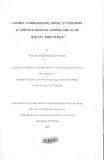| dc.contributor.author | Menge, Tom B | |
| dc.date.accessioned | 2016-06-17T08:08:26Z | |
| dc.date.available | 2016-06-17T08:08:26Z | |
| dc.date.issued | 2007 | |
| dc.identifier.uri | http://hdl.handle.net/11295/96127 | |
| dc.description.abstract | Pesticide poisoning is an important cause of worldwide morbidity and mortality. This is because pesticides are widely available and extensively used in households for human and animal hygiene and in agriculture for crop protection and pest control. Amitraz is a synthetic formamidine pesticide that is used to control ticks, mites and other insects in livestock and other domestic animals, as well as red spider mites and other pests in fruit crops. It is widely available in Kenya where it is mainly used in cattle to control ticks and mites.
The current study was undertaken to determine the prevalence of amitraz poisoning among patients admitted with pesticide poisoning in Kenyatta National Hospital, Nairobi. The other objective was to determine the intraperitoneal median lethal dose (LD50) of amitraz in laboratory animals and study the effect of yohimbine antagonism and urinary alkalination on the relative toxicity of
amitraz.
A demographic survey was conducted to determine prevalence of amitraz poisoning in Kenyatta National hospital and document the diagnosis, management and outcome of all patients admitted with pesticide poisoning. Data was compiled by reviewing files from 1004 patients admitted at the hospital with poisoning for a six year study period from January 2000 to December 2005. Pesticide poisoning accounts for 0.2% of the patients admitted in the hospital. Amitraz accounted for 8.3% of the cases reviewed, while rodenticides accounted for 34.9% and organophosphates 34.0% of poisoning patients admitted in the hospital. The survey indicated that amitraz is assumed to be an organophosphate and the management of patients consistently made with this assumption. Poisoning occurs in all age groups, with children below 12 years accounting for 9% of the cases reviewed.
Acute toxicity studies were conducted to determine the median lethal dose (LD50) of amitraz in rats, and the effect of yohimbine antagonism and urinary alkalination on the relative toxicity of amitraz. The intraperitoneal acute median
lethal dose (LD50) and 95% confidence limits in mg/kg for amitraz in rats was 75.01 (58.1 to 96.8). The intraperitoneal LD50 following yohimbine antagonism was 78.11 (65.84 to 92.66) mg/kg while the intraperitoneal LD50 following urinary alkalination with sodium bicarbonate was 91.85 (72.86 to 115.8) mg/kg.
The study shows that yohimbine antagonism marginally, though significantly increases the acute median lethal dose, and hence reduces the relative toxicity of amitraz in rats. Urinary alkalination with sodium bicarbonate also increases the LD50 and reduces the relative toxicity of amitraz in rats.
As indicated, the management of most cases of amitraz poisoning is based on the assumption that amitraz is an organophosphate; the study therefore recommends for the education of doctors and others healthcare professions on the classification and management of amitraz and other common toxicants. Further research is necessary to determine the usefulness of urinary alkalination in the management of amitraz poisoning. | en_US |
| dc.language.iso | en | en_US |
| dc.publisher | University of Nairobi | en_US |
| dc.rights | Attribution-NonCommercial-NoDerivs 3.0 United States | * |
| dc.rights.uri | http://creativecommons.org/licenses/by-nc-nd/3.0/us/ | * |
| dc.subject | Acute Toxicity Study in Rats | en_US |
| dc.title | Amitraz: a demographic survey of poisoning at Kenyatta National Hospital and acute toxicity study in rats | en_US |
| dc.type | Thesis | en_US |
| dc.description.department | a
Department of Psychiatry, University of Nairobi, ; bDepartment of Mental Health, School of Medicine,
Moi University, Eldoret, Kenya | |



